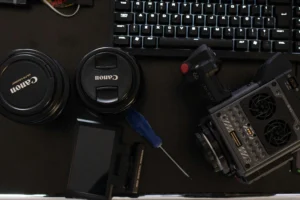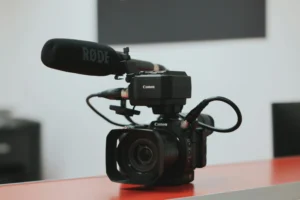Which Canon Camera is best for Filmmaking?
A Complete Handbook for 2025 Filmmakers
In filmmaking, the correct camera may either enhance or destroy your creative vision. Even though entry-level DSLRs and cellphones have greatly advanced, directors—beginners, intermediates, or professionals—still rely on manufacturers like Canon for industry-grade video capability. Often top competitors in the filmmaking scene, Canon cameras are well-known for their vivid colour science, outstanding focusing, and cinematic video capabilities.
But which Canon camera would be ideal for 2025 filmmaking?
Popular Canon models will be compared in this extensive guide, along with their features, advantages, disadvantages, and fit for various filmmaking requirements.
Why Canon for filmmaking?
Before we get into certain models, let’s consider why Canon is a favourite among directors:
- Canon’s well-known colour technology generates genuine skin tones and dramatic colours right out of the camera.
- Lens Ecosystem: Filmmakers have creative freedom with the many EF, RF, and Cinema lenses.
- Perfect for single shooters, Canon’s Dual Pixel CMOS focusing (DPAF) is among the quickest and most dependable focusing systems.
- Canon has 10-bit internal recording, C-Log, and high frame rates for slow-motion, among other choices.
- Canon cameras are well-known for their easy menus and comfortable designs.
Top Canon cameras for 2025 filmmaking
1. Canon EOS R5 C (Hybrid King)
Why would-be directors like it?
Combining the best of Canon’s EOS R mirrorless range with its Cinema EOS series, the Canon EOS R5 C is a formidable hybrid camera. It’s designed especially for filmmakers who require high-res photographic capabilities but desire cinema-level video.
Fundamental Characteristics:
- RAW video capturing 8K 60p.
- Four thousand over, sampled from eight thousand.
- Unrestricted recording period.
- Eye Detection combined with dual-pixel CMOS AF.
- System for active cooling.
- Ten-bit 4:2:2 internal Canon Log 3 recording.
- Perfect for: independent producers, professional directors, and documentaries.
- Prices range: $4,299 (body alone) 2025
Benefits include:
- Amazing eight-kilometer clarity.
- Focused UI with videos in mind.
- Superior low-light performance.
- Dual SD card slots and CFexpress.
Disadvantages:
- More weight than standard mirrorless bodies.
- For 8K RAW, it needs CFexpress cards.
2. Canon EOS C70, also known as Cinema Beast in Compact BodyThe reasons for filmmakers’ fondness for it
Perfect for documentary producers, commercial photographers, and independent filmmakers, the Canon EOS C70 delivers the capability of Canon’s Cinema EOS line into a small package.
Key Characteristics:
- Dual Gain Output Super 35mm DGO sensor.
- 4K 120fps slow-motion footage.
- Built-in ND filters.
- Two Canon Logs: Log two and Log 3.
- RF Mount using an adapter with complete EF lens compatibility.
- Ideal for: independent directors, commercial directors, and event videographers.
- ($5,499, body alone) Price Range 2025
Advantages:
- Great dynamic range.
- Expert audio sources
- Lightweight and small.
- Perfect for portable shooting.
Negative aspects include:
- It is not a full-frame sensor; it is a Super 35mm.
- Not an internal RAW recording.
3. Best Budget for Indie Filmmakers – Canon EOS R6 Mark II
Why do directors like it?
Budget-conscious directors who still want Canon’s cinematic colour science and robust 4K capabilities will find great value in the EOS R6 Mark II.
Essential Characteristics:
- 4K 60p oversampled out of 6K.
- Ten-bit 4:2:2 internal recording using C-Log 3.
- Sensor with full frame.
- Great IBIS, or in-body image stabilisation.
- AF II for dual pixels CMOS.
- Perfect for wedding videographers, amateur filmmakers, and YouTubers.
- Price Range (2025): Body Only: $2,499
Advantages:
- Small and easily travelable.
- Excellent low-light capability.
- For a full-frame mirrorless, reasonably priced.
- Most times, there is no overheating.
Constraints:
- No eight-K recording.
- There isn’t a built-in fan, so an excessive 4K 60p recording might lead to heat generation.
4. Canon EOS R3, for action-oriented cinematography
The reasons for filmmakers’ fondness for it
Though mostly a photographic flagship, the Canon EOS R3 has features appealing to action and documentary filmmakers seeking rapid focusing, high frame rates, and robust build quality.
Essential Characteristics:
- Six thousand sixty-p RAW videos.
- Four thousand over, sampled from six thousand.
- AF, Eye Control
- CMOS AF II with dual pixels.
- Professional body sealed from the weather.
- Ideal for sports videographers, wildlife filmmakers, and documentary shooters.
- ($5,999, body alone) Price Range 2025
Positives:
- Very precise and rapid autofocus.
- 6K internal RAW.
- Designed for rough conditions.
- Lengthy battery life.
Drawbacks include:
- For portable usage, bulky.
- Costlier than the R5C.
5. Canon EOS Mark III for High-End Filmmaking
Why do directors like it?
Thanks to its Super 35mm DGO sensor and professional-grade capabilities, the Canon EOS C300 Mark III is still a pillar in the business for high-end projects, ads, and narrative filmmaking.
Main characteristics:
- 4K 120 frames per second.
- Super 35mm dual gain output sensor.
- Dynamic range of sixteen-plus stops.
- Modular constructions.
- Log 2 and 3 for Canon.
- Perfect for documentaries, feature films, and commercial projects.
- Prices range 2025: $ 10,999 (body alone).
Benefits:
- Unparalleled dynamic range.
- Expert timecode, SDI, and XLR connectors.
- Internal RAW Light recording.
- An industry-standard process of work.
Drawbacks include:
- Expensive.
- Calls for rigging for portable application.
How Should One Select a Canon Camera Based on Filming Requirements?
These are some important factors:
Budget:
The EOS R6 Mark II is rather reasonably priced for independent or beginner filmmakers. The C300 Mark III or EOS R5 C are better options for upscale projects.
Category of Projects:
- Documentaries or event coverage: EOS C70 or R3.
- Commercials or narrative films: EOS R5 C or C300 Mark III.
- EOS R6 Mark II or R5 C for Travel & Vlogging.
Size Preference for Sensors:
- EOS R5 C, R3, R6 Mark II looks full-frame.
- Super 35mm (filmic texture): EOS C70, C300 Mark III.
Form Factor:
- R5 C, R6 Mark II: hybrid mirrorless.
- C70, C300 Mark III dedicated cinema camera.

Conclusion
For most filmmakers in 2025, Canon EOS R5 C is maybe the greatest all-rounder that provides excellent movie quality and stills in one body.
The Canon EOS C70 provides the ideal mix of professional-grade capabilities and a small body for those volunteering for pure movie production. For cinematic narrative without breaking the budget, budget artists will discover the Canon EOS R6 Mark II a potent, reasonably priced instrument.
Five Often Asked Questions (FAQs)
1. Is filmmaking suited for Canon EOS R5?
Indeed, the Canon EOS R5 is perfect for filmmaking as it provides C-Log 3, 8K 30p, and 4K 120p. However, the EOS R5 C is a superior option if you want active cooling and limitless recording.
2. Can I film 2025 with Canon DSLRs like the 90D?
While cameras like the Canon 90D may still capture acceptable video, they lack capabilities like 10-bit internal recording, IBIS, and sophisticated autofocus found in newer Canon mirrorless and movie cameras.
3. Compared to the EOS R5 C, is the Canon EOS C70 better?
Both are good, yet they fulfil distinct requirements. The R5 C is a hybrid stills/video camera with 8K capability; the C70 is more of a pure cinema camera with built-in ND filters and improved audio inputs.
4. Which Canon camera is ideal for YouTube filmmaking?
For YouTubers and vloggers, the Canon EOS R6 Mark II is a fantastic option due to its small size, full-frame sensor, superb focusing, and exceptional image stabilization.
5. Can I film material permitted by Netflix using Canon cameras?
Yes, Canon cameras like the EOS C300 Mark III and EOS C70 are Netflix-approved, satisfying the platform’s stringent quality criteria for original video.
